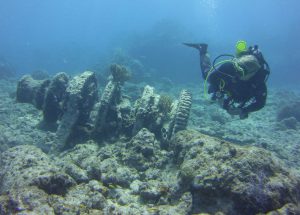Sanctuary: “a place of refuge or safety” and “a nature reserve,” according to Oxford Languages.
The National Marine Sanctuary System was established in 1972 for the purposes of conservation, research and monitoring, and education and outreach. In the United States, 15 National Marine Sanctuaries and two National Marine Monuments exist. These highlight cultural resources from shipwrecks to natural resources like coral reefs and seagrasses. National Marine Sanctuaries work with partners and stakeholders to ensure sustainable use and protection of these areas. This is similar to the missions of county, state, and national parks; however, the main difference is that marine sanctuaries are referring specifically to protected areas within the ocean or great lakes. Here in southeast Florida, we are fortunate to have our own marine sanctuary practically in our backyard–the Florida Keys National Marine Sanctuary (FKNMS).

Established in 1990, the FKNMS encompasses 2,900 nautical square miles consisting of coral reefs, seagrass, and mangroves. While many are familiar with the “Welcome to the Florida Keys National Marine Sanctuary” sign that greets them on Overseas Highway just outside Key Largo, something not commonly known is that the northernmost boundary of the FKNMS is actually offshore of Miami-Dade-County, east of Biscayne National Park. That means that the FKNMS extends off of the shores of both Miami-Dade and Monroe counties. The FKNMS is jointly managed by the National Oceanic & Atmospheric Administration and the State of Florida.

Throughout the first week of August, the Office of National Marine Sanctuaries will host “Get Into Your Sanctuary,” a series of virtual events open to people across the country. In addition to learning more about our local sanctuary topics including white abalone, World War II shipwrecks, seabirds and more will be presented. To view the list of “Get Into Your Sanctuary” events, please go here:
https://sanctuaries.noaa.gov/visit/giys.html
or submit photographs from your favorite sanctuary to the annual photo contest here:
https://sanctuaries.noaa.gov/photo-contest.html.
 1
1
